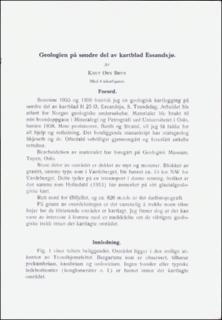Geologien på søndre del av kartblad Essandsjø.
Journal article

Åpne
Permanent lenke
https://hdl.handle.net/11250/2674703Utgivelsesdato
1959Metadata
Vis full innførselSamlinger
- Artikler [1064]
Sammendrag
The field observations were made during 1955 and 1956. The most important types of rocks are as follows. Near the SE corner of the map there is granite surrounded by quartz porphyry. This is overlain by another porphyry, suppoed to be allocthonous. To the west there is an overlying series consisting of amphibolite, mica schist and sandstone, called Essandsjø schist. In the lower part of this series, there is an abandoned copper mine. These rocks occupy the central part of the map. Farther west there is a garben schist, overlain by Stuedal schist, which is characterized by biotite porphyroblasts. These two schists are characterized for the Røros group, which is of Cambiran and lower Ordovician age. The two biggest mountains, Sylene and Øifjell, consist of amphibolite, obviuosly allocthonous. The amphibolite and the rocks of the Røros group belong to the epidote-amphibolite facies. Most of the structures in the field indicate a stress and transport from NW to SE.
